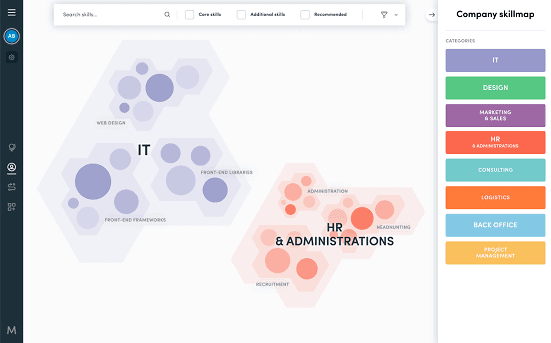
How to make the most of a skills gap analysis: the all-in-one guide

According to a study by SHRM, 75% of HR professionals say there is a shortage of skills in candidates for job openings. As many as 83% report struggling with recruiting suitable candidates. However, not all employers know how to identify and bridge this competency gap.One of the best ways of doing this is by conducting a skills gap analysis. Below, we discuss how it can help your business achieve its goals by guiding your recruitment efforts and making the most of your employees’ skills.
What is a skills gap analysis?
Skills gap analysis is a tool used to evaluate your employees’ training requirements and to establish your company’s hiring needs. When you analyze your team’s or individual employees’ skills gap, you get to see how far your business is from reaching its goals or desired levels of competencies. As a result, you’ll know whether you need to put an emphasis on hiring or training employees. You will thus be able to come up with a tangible plan.
Why is it important that employers turn to skills gap analysis? In their 2019 Global Skills Shortage report, SHRM warns that the skills gap won’t be going away by itself. In fact:
“Over 50% of respondents feel that skills shortages have worsened or greatly worsened in their organizations in the last two years. Less than 10% of respondents report skills shortage improvements”.
Source:SHRM
The struggle for companies is real – and so, it’s time to act!
What are the benefits of skills gap analysis?
Conducting a thorough skills gap analysis can positively impact your business in many areas, most notably:
Identifying your employees’ training needs
By analyzing your employees’ strengths and weaknesses, you’ll be able to establish the training each of them genuinely requires. This is important, as employees often aren’t getting trained in the skills they need.
As aptly pointed out by Capterra:
“At a time when companies are spendingmore than $1,200 per employee, per year on training, doing a skills gap analysis can tell you how you should prioritize that training spend to get the best results”.
Source: Capterra
Strategic talent management
If you conduct a skills gap analysis for your entire team – and not just individual employees – you’ll be able to plan a long-term employment strategy. As a result, you’ll know which talent management efforts to focus on to stay relevant to the market (and outpace your competitors).
Saving money
Through the course of analyzing your teams’ skill gaps, you might discover that you don’t need that extra tech employee you were expecting to hire. Perhaps, one of your current employees already fits the candidate profile by 80%, and would only need additional training to perfectly fill the role?
On the other end, skills gap analysis will also help you avoid overtraining, i.e. sending employees to training on subjects they are already proficient in.
Optimizing your ideal candidate profile
When you find out your team’s weakest link, you’ll be able to hire for the missing skill.
Getting external support – quickly
As mentioned above, you won’t always need to hire a new employee. However, if it’s not possible to quickly train your employees to reach an expert level in a given skill, you can always hire an external contractor.
Creating career paths
If there’s one thing that can seriously undermine your skills gap alleviation efforts, its employees leaving due to lack of training. Skills gap analysis will help you design individual career paths for your employees.
In fact, it’s a true win-win scenario! If you develop your talent internally, your employees will feel cared for, which will lead to the reduction of your employees’ attrition rate.
Now that we’ve discussed how immensely helpful analyzing your company’s skillset is, let’s look at a step-by-step plan.
How to conduct a skills gap analysis? A step-by-step approach
Skills gap analysis can be roughly divided into 4 stages. Depending on your approach, you’ll need to engage not just HR, but also your team leaders, and – potentially – external evaluators.
Step 1: Understand when, how, and whom to test.
Before you dive in and peruse your employees’ profiles, the key question you’ll need to ask yourself is:
Do I want to analyze each employee’s skills individually, or look at them at a team- or company-level?
Conducting a company-wide skills gap analysis is beneficial to the whole organization because it gives you a bird’s eye view of the skills you have and those that are lacking. For that reason, the skills gap analysis can be successfully conducted at any point in time, but it has been traditionally associated with the following scenarios:
|
Who is being evaluated |
A good time for skills gap analysis |
Who should conduct it |
|
Employee |
|
The employee’s direct manager. |
|
Team |
|
HR, HR and the team leader, or external evaluators |
Step 2: Identify the skills that are most important to you.
Once you’ve established the extent of your skills gap evaluation, you’ll have to strategize for business goals. Ideally, in this step, you should also engage your C-level management.
Make a list of the skills your company needs now and in the future – consider both short-term and long-term goals and market scenarios. For example, if you’d like your company to start working on machine learning projects, you need to write down all the skills that are required for that to happen. You might also benefit from brainstorming any emerging technologies that might dominate the scene in a couple years from now.
Step 3: Collect and analyze employee data.
It’s time to start collecting information on your employees’ current abilities!
Start by taking a look at all the data you’ve already gathered. Perhaps, there’s information on your employees’ CVs, LinkedIn profiles, or in recent performance reviews.
Once you’ve gathered the data, it’s time to supplement your current knowledge. We recommend that you turn to the following methods:
- conducting interviews with your employees
- running surveys (for instance, asking your employees to subjectively evaluate their expertise on a scale from 1 to 5).
- running skills assessments (i.e. by leveraging skills screening software)
Once you’ve collected all the data, the next step is to use a competency map tool likeTalentBoost to visualize your skills gap analysis results.
 Image source: TalentBoost
Image source: TalentBoost
Hence, using it to analyze your skills gap analysis will let you see:
- what skills are most underrepresented in your team
- how far from competency-related goals your company is
- what job positions your employees could evolve towards, given their current abilities
With all this, it’s time to put things into play.
Step 4: Create an action plan.
Based on your findings, you’ll have two potential solutions:
Investing in training
Does it look like your team can quickly acquire a new skill? Establish whether your employees can be trained in-house (for example, through online courses and mentorship programs), or need more formal training, like enrollment in a certification program.
Hiring new employees
Look at the competency map you’ve created, and check which important skills are entirely missing in your team.
Put these skill gaps at the center of your recruitment efforts. Make sure to add your skills gap analysis data to your recruitment plan so that you can plan ahead. To make sure each new person joining your team has the right skills, make sure to familiarize yourself with key job interview techniques for employers.
Summary
Skills gap analysis is key to effective talent management and remaining relevant to the ever-changing market. By keeping track of your employees’ skills, you’ll be able to optimize your talent management strategy, identify your team’s actual training needs, and focus your recruitment efforts on the absolute most-fitting candidates.
One of the best ways of keeping track of your team’s skill sets is using a competency map like MapSkiller. By using it regularly, you’ll gain clarity and know which direction you should take your team to reach your long-term business goals.
Image credit: Stephen Dawson on Unsplash




